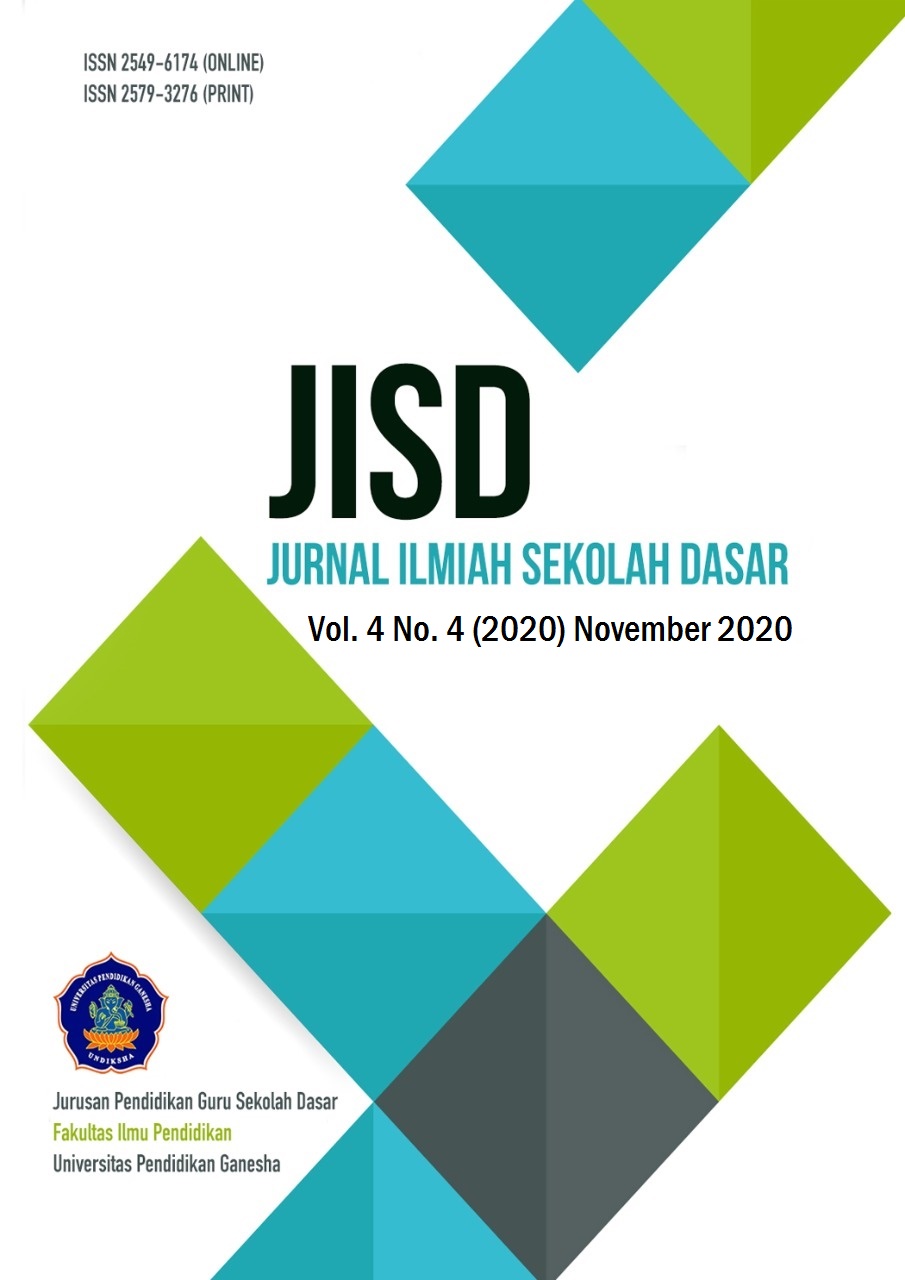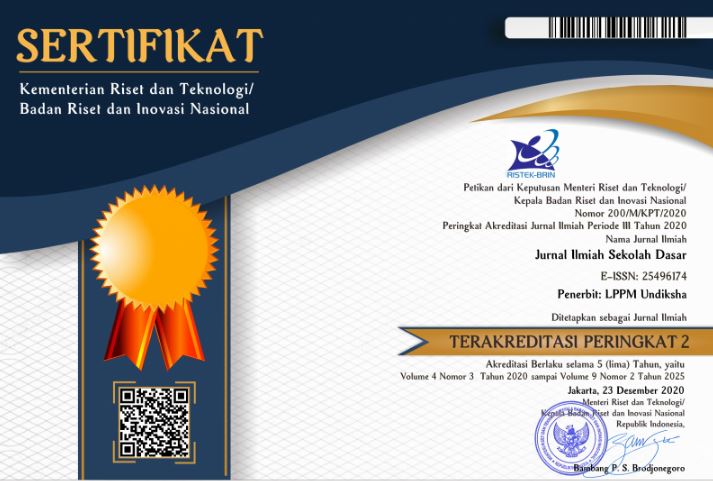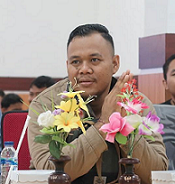The Effectiveness of Audio on Learning Outcomes to Understand the Intrinsic Elements
DOI:
https://doi.org/10.23887/jisd.v4i4.29313Abstract
Learning process in the school, teachers must be more innovative in the terms of storytelling. The low ability of students in understanding a story. An alternative that can increase students understanding of the ability of understanding stories is the presence of media. Media in learning has a very important function, namely as a tool that can affect the place of learning that is being managed by the teacher. If the teacher wants to increase interest in new learning, they must use media in learning activities. The aim of this research is to know the effectiveness of the use of audio media in learning understand the intrinsic elements of fairy tales on learning outcomes before and after the action on the second grade students of Elementary school of Rejoagung. This study uses a research design model of One Group Pretest Posttest Design. By using t test statistical analysis to see the effectiveness of using audio media in learning to understand the intrinsic elements of fairy tales on learning outcomes. It can be seen in the t test in learning, there is an effective use of audio media in learning to understand the intrinsic elements of fairy tales on learning outcomes.References
Andrean, Seka. (2019). Pengembangan Media Pembelajaran Berupa Wayang Kartun pada Pembelajaran Tematik Kelas IV di SD/MI Bandar Lampung. Skripsi. Universitas Islam Negeri Raden Intan Lampung, Lampung.
Arsyad, Azhar. (2015). Media Pembelajaran. Jakarta: PT Rajagrafindo Persada.
Artana, I Ketut. (2017). Anak, Minat Baca, dan Mendongeng. Jurnal Acarya Pustaka 3(1), 26-36.
Azhari. (2015). Peran Media Pendidikan Dalam Meingkatkan Kemampuan Bahasa Arab Siswa Madrasah. (Program Pascasarjana UIN Ar-Raniry Banda Aceh).
Fatimah. (2019). Pengaruh Penggunaan Audio Terhadap Kemampuan Berbicara Anak Kelompok B. E-Jurnal Skripsi Program Studi Teknologi Pendidikan 8 (3), 179-187.
Habsari, Zakia. (2017). Dongeng sebagai Pembentuk Karakter Anak. Jurnal Kajian Perpustakaan dan Informasi 1 (1), 21-29.
Mansyur, Umar. (2016). Inovasi Pembelajaran Bahasa Indonesia Melalui Pendekatan Proses. Jurnal Bahasa, Sastra, dan Pengajarannya 9 (2), 90-163.
Maryatin. (2018). Studi Komparasi Hasil Mendengarkan Cerita Rakyat “Timun Mas” dengan Menggunakan Media Audio dan Tidak Menggunakan Media Non Audio di SDN 033 Balikpapan. Jurnal Bahasa, Sastra, dan Pengajarannya 3 (1), 19-26.
Mawadah, Esti Nur. (2019). Peningkatan Keterampilan Menyimak Dongeng Melalui Media Wayang Kartun dalam Pembelajaran Bahasa Indonesia pada Kelas II MI Darussalam Kec. Bancak Kab. Semarang Tahun Pelajaran 2018/2019. Skripsi. Institut Agama Islam Negeri Salatiga.
Pratiwi, Anisa Yuni. (2016). Keefektifan Media Audio Visual Terhadap Motivasi dan Hasil Belajar Mengidentifikasi Unsur-Unsur Cerita Anak Pada Kelas V SDN Grobog Kulon 01 Kabupaten Tegal. Skripsi. Universitas Negeri Semarang.
Prayogo, Evan Ardi. (2015). Peningkatan Kemampuan Mengidentifikasi Unsur Intrinsik Cerita Melalui Media Audio Pembelajaran pada Siswa Kelas V SDN Panggungduwut 01 Kabupaten Blitar. Skripsi. Universitas Negeri Malang.
Silalahi, Wesly. (2017). Meningkatkan Motivasi Belajar Bahasa Indonesia dengan Menggunakan Model Pembelajaran Kooperatif Tipe TGT (Teams Games Tournament) pada Siswa Kelas IV SD Negeri 106815. Elementary School Journal PGSD FIP UNIMED 7 (4), 512-519.
Sugiono. (2018). Metode Penelitian Pendididkan Pendekatan Kuantitatif, Kualitatif, dan R&D. Bandung: Alfabeta.
Wahyuni, Sri. (2017). Unsur Intrinsik Dongeng Bertrand Solet dan Michel Cosem dan Implikasinya Terhadap Pembelajaran. Jurnal Pendidikan Bahasa Prancis 2 (1), 1-12.
Widayah, Sri. (2017). Penggunaan Media Audio Visual untuk Meningkatkan Kemampuan Siswa dalam Memahami Unsur Intrinsik Cerita di Kelas VI SDN JOGOSATRU. Jurnal Riset Pedagogilk UNS.
Winarni, Endang Widi. (2018). Teori dan Praktik Penelitian Kualitatif Kuantitatif Penelitian Tindakan Kelas (PTK) Research and Development (R&D). Jakarta: Bumi Aksara.
Zainuruddin, Ahmad Hanif. (2016). Peningkatan Kemampuan Memahami Isi Dongeng Melalui Pembelajaran SQ3R (Survey, Question, Read, Recite, Review) pada Siswa Kelas III SDN Purwodadi 2 Kecamatan Blimbing Kota Malang. Skripsi. Universitas Negeri Malang.
Published
How to Cite
Issue
Section
License
Authors who publish with the Journal Ilmiah Sekolah Dasar agree to the following terms:
- Authors retain copyright and grant the journal the right of first publication with the work simultaneously licensed under a Creative Commons Attribution License (CC BY-SA 4.0) that allows others to share the work with an acknowledgment of the work's authorship and initial publication in this journal.
- Authors are able to enter into separate, additional contractual arrangements for the non-exclusive distribution of the journal's published version of the work (e.g., post it to an institutional repository or publish it in a book), with an acknowledgment of its initial publication in this journal.
- Authors are permitted and encouraged to post their work online (e.g., in institutional repositories or on their website) prior to and during the submission process, as it can lead to productive exchanges, as well as earlier and greater citation of published work. (See The Effect of Open Access)











